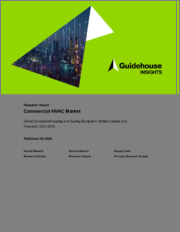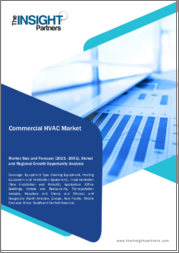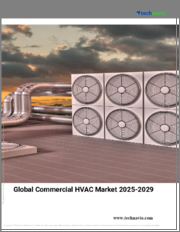
|
시장보고서
상품코드
1561100
세계의 상업용 HVAC 시장 : 상업용 냉난방기기 시장 분석 및 예측(2024-2033년)Commercial HVAC Market: Global Commercial Heating and Cooling Equipment Market Analysis and Forecasts, 2024-2033 |
||||||
세계의 상업용 HVAC(난방, 환기 및 공조) 기기 시장은 향후 10년간 성장할 것으로 예상되고 있습니다. 기업의 지속가능성에 대한 자발적인 헌신, 건물의 탈탄소화 규제의 의무화, 냉방기기 채용 확대 등 여러 시장 성장 촉진요인이 수익 확대에 기여할 것으로 보입니다. 반면에 엄격한 거시경제 상황, 탈탄소화 개조 문제, 공급측 병목 현상 등 시장 성장을 둔화시키는 여러 장벽에도 직면하고 있습니다.
상업용 HVAC 시장에서는 제조업체, 유통업체, 유통업체, 계약자, 엔지니어링 기업 등 공급측의 이해관계자에 의한 경쟁이 치열합니다. 최근 M&A(합병 및 인수)는 특히 장비 제조업체 간 시장 경쟁의 치열성을 이야기하고 있습니다. 전반적으로 M&A는 지난 몇 년동안 활발히 진행되었으며 감속 조짐은 당분간 없습니다.
본 보고서에서는 시장 성장 촉진요인, 장벽 및 시장 동향이 향후 10년간의 상업용 HVAC 시장에 어떤 영향을 줄 것인지를 평가합니다. 또한 시장의 주요 이해관계자와 업계 밸류체인에서의 역할의 개요를 설명하고, 시장이 단기적 및 장기적으로 발전하는 가운데 경쟁력을 유지하는 방법에 대해 제안하고 있습니다. 본 보고서에서는 2024년부터 2033년까지의 상업용 HVAC의 수익 성장을, 기술유형별(패키지 에어컨(AC), 스플릿 AC, 칠러, 히트 펌프, 보일러), 건설유형별(기존 건축물, 신축), 세계의 지역별(북미, 유럽, 아시아태평양, 라틴아메리카, 중동 및 아프리카)로 추정 및 예측했습니다.
목차
제1장 주요 요약
제2장 시장 문제
- 서문
- 상업용 HVAC의 기술
- 성장 촉진요인
- 누적 교환 수요
- 기업의 지속가능성에 대한 노력
- 정책 및 규제
- 정부 투자 및 인센티브
- 냉방장치의 도입
- 장벽
- 거시 경제 상황
- 탈탄소화 개수의 과제 및 초기 비용
- 공급측의 병목
제3장 산업 밸류체인
- 밸류체인 및 시장의 이해관계자
- 경쟁 구도
- M&A 활동
제4장 시장 예측
- 조사 방법
- 세계 시장
- 북미
- 유럽
- 아시아태평양
- 라틴아메리카
- 중동 및 아프리카
제5장 결론 및 제안
- 3개의 큰 포인트
- 추천
- 제조업체
- 엔지니어링 기업 및 계약자
- 빌딩 소유자 및 시설 관리자
제6장 약어 및 약어의 일람
제7장 목차
제8장 도표
제9장 조사 범위, 정보 출처 및 조사 방법, 주석
AJY 24.10.08The global commercial HVAC equipment market is expected to grow over the next decade. Several market drivers are likely to contribute to revenue growth, including voluntary corporate sustainability commitments, mandatory building decarbonization regulations, and growing cooling equipment adoption. At the same time, the market also faces several barriers that can slow revenue growth, including challenging macroeconomic conditions, decarbonization retrofit challenges, and supply-side bottlenecks.
The commercial HVAC market is highly competitive among supply-side stakeholders, including manufacturers, distributors, sales representatives, contractors, and engineering firms. Recent mergers and acquisitions (M&A) illustrate the competitive nature of the market, particularly among equipment manufacturers. Overall, M&A activity has been robust in the last few years and does not show signs of slowing down in the near term, suggesting the market is likely to continue growing and changing over the next decade.
This report evaluates how market drivers, barriers, and trends are likely to affect the commercial HVAC market over the next 10 years. It provides an overview of the key market stakeholders and their role in the industry value chain, and offers recommendations for how they can stay competitive as the market evolves in the near and long term. The forecasts in this report estimate commercial HVAC revenue growth from 2024 to 2033, segmented by technology type (package air conditioners [ACs], split ACs, chillers, heat pumps, boilers), construction type (existing buildings, new construction), and global region (North America, Europe, Asia Pacific, Latin America, Middle East & Africa).
Table of Contents
1. Executive Summary
2. Market Issues
- 2.1 Introduction
- 2.2 Commercial HVAC Technologies
- 2.3 Drivers
- 2.3.1 Pent-Up Replacement Demand
- 2.3.2 Corporate Sustainability Commitments
- 2.3.3 Policies and Regulations
- 2.3.4 Government Investments and Incentives
- 2.3.5 Cooling Equipment Adoption
- 2.4 Barriers
- 2.4.1 Macroeconomic Conditions
- 2.4.2 Decarbonization Retrofit Challenges and Upfront Costs
- 2.4.3 Supply-Side Bottlenecks
3. Industry Value Chain
- 3.1 Value Chain and Market Stakeholders
- 3.2 Competitive Landscape
- 3.2.1 M&A Activity
4. Market Forecasts
- 4.1 Methodology
- 4.2 World Markets
- 4.3 North America
- 4.4 Europe
- 4.5 Asia Pacific
- 4.6 Latin America
- 4.7 Middle East & Africa
5. Conclusions and Recommendations
- 5.1 Three Big Takeaways
- 5.2 Recommendations
- 5.2.1 Manufacturers
- 5.2.2 Engineering Firms and Contractors
- 5.2.3 Building Owners and Facilities Managers



















